The art of stillness: Pico Iyer in TED
'People will forgive you for being wrong, but they will never forgive you for being right - especially if events prove you right while proving them wrong.' Thomas Sowell
Search This Blog
Monday, 1 December 2014
Private schools know how to game elite universities – state-educated kids don’t have this privilege
The system fails bright pupils from ordinary backgrounds. And here’s how we all lose ...

Let’s call him Matt. Aged 16, he is tall, taciturn and highly talented. He goes to a state school and is about to choose his A-levels. For all kinds of reasons, he believes he should progress, via Oxbridge or the Ivy League, to become an aerospace engineer.
So should he do further maths? If maths is the new rock’n’roll in education, then further maths is a VIP enclosure that fewer than 15,000 young people a year get into.
Last week, I had the chance to put this question to the deputy head of a top private school. “By all means do further maths, but only if you are guaranteed to get an A,” came the answer, as if it were a no-brainer. It was advice born out of years of practical knowledge.
Other opinions are available of course – and that’s the problem. This year, a quarter of a million 16-year-olds will make their A-level choices relying on hearsay, myth and information that is outdated or uncheckable. Those choices will shape their options when it comes to university – and the courses they apply for will then shape their chances of getting in.
There is, in short, massive asymmetry of information in the post-16 education system and the critical determinant is class. Kids at private school can rely on schools that have continual informal contact with elite universities. The result is that – for all the hard work being done by outreach teams in Russell Group universities, and by access teams in state schools – there’s an inbuilt advantage among those going to private schools based on informal knowledge.
Last year’s results for further maths demonstrate the problem. In English state schools, further education and sixth-form colleges, about 11,100 young people sat the exam; in the private sector, which accounts for just 7% of the school population, 3,600 sat it. And private school results were better, with 69% getting A or A* versus 54% in state schools.
Government tables show that this achievement gap is even more pronounced for ordinary maths and the three main science subjects. There are numerous private websites that offer A-level advice, and anecdotally social media are abuzz with the wisdom of teenage crowds over course and subject choices.
But why isn’t there a central repository of information that would turn all this folkore into a level playing field of checkable knowledge? Why isn’t there a single, open-source database that models all specific pathways into higher education? Without it, state school students will always find it hard to win the inside-knowledge game.
At my old university, Sheffield, they told me that you need maths and physics as part of three A grades to study aerospace engineering. That’s in line with the Russell Group’s guide, which also tells you to add design/technology, computer science or further maths.
The admissions tutor of an Oxbridge college, however, tells me: “I think here they’d be worried about no further maths, especially if it was offered at school but they didn’t take it, though I do worry that we send out mixed messages about this.”
The knowledge asymmetries deepen once you realise that elite universities require additional, bespoke tests. Cambridge University’s website reveals that if you want to do engineering at Christ’s, Peterhouse or St John’s you might need to take an extra exam called Step.
In a cantankerous, unsigned diatribe, the Step chief examiner for 2014 complains that only 3.8% of applicants scored top marks. The majority were not prepared for the kind of thinking they had to do. “Curve-sketching skills were weak,” the examiner noted, together with “an unwillingness to be imaginative and creative, allied with a lack of thoroughness and attention to detail”.
I will wager that the people who scored top marks knew that their curves had to look like Leonardo da Vinci’s and that they had to demonstrate imagination and creativity – because their teachers had long experience of this exam, and the others had not. One Oxbridge admissions tutor admitted to me that such testing may add a further barrier to people from state schools.
Suppose Matt wants to go to Oxbridge more than he wants to be an aerospace engineer? Here the advice is – for those in the know – really clear. Don’t apply for the most popular courses, where there can be 12 people for every place. Work out the college and subject combinations that reduce the odds to just three or four to one.
Oxford’s website shows the success ratio for getting on to its popular engineering and economic management course is just 10%, while the success rate of applications for materials science is 42%. A senior administrator at Oxford told me that they suspected few state school teachers really understand this game of playing the ratios. State-school students and people from ethnic minorities crowd each other out by going for the same, obvious, high-ratio and vocational courses.
Why should this matter to the majority of young people, who do not aspire to go to an elite university? And to the rest of society? First, because it is creating needless inequality of opportunity and is just the most obvious example of how poor access to informal knowledge penalises state school kids. Second, because in an economy set to be dominated by information and technology, those 15,000 people who can attempt further maths each year are the equivalent of Aztec gold for the conquistadores. Their intelligence will be the raw material of the third industrial revolution.
There is no reason – other than maintaining privilege – to avoid presenting subject and course choices clearly, logically and transparently. When the system fails bright kids from non-privileged backgrounds, we all lose.
Saturday, 29 November 2014
Important Health Warning
As many as 8 lakh international students, including about 96,000 Indian students, are at a huge disadvantage in the USA for no health insurance will pay more than 80 percent of their medical bills—that too after a one-time deductible of $500 (Rs 30,000) on first visit to a clinic.
ABHIJIT MAZUMDAR in Outlook India
Dushyant Kumar, a student at the University of Illinois in the U.S., was having bouts of intermittent spasms in his stomach but a visit to the university hospital made him double up in pain on learning about staggering amount of money he would have to spend on medical tests. As an international student, Kumar said, “Despite having student health insurance cover, I was supposed to shell out $600 (Rs 36,000) for only an ultrasound.”
Healthcare remains a concern for Indian students as well as citizens of the U.S. While U.S. citizens have health insurance cover that would pay a substantial portion of their medical bills, as many as 8 lakh international students, including about 96,000 Indian students, are at a huge disadvantage for no health insurance will pay more than 80 percent of their medical bills—that too after a one-time deductible of $500 (Rs 30,000) on first visit to a clinic.
Procedures such as an ultrasound or a CT scan cost upward of $1000 (Rs 60,000) in the U.S, which essentially means an international student first pays $500 (Rs 30,000) one-time deductible and another $100 (Rs 6,000) as 20 percent of the total cost he is supposed to shoulder. All this after he pays a huge sum for being insured for the year.
Mounting healthcare cost is a bane on a society that has over 5,500 hospitals and 8 lakh doctors to cater to a population of about 31 crore. Sample this—a woman delivering a kid, and that too without complications, will pay about $30,000 (Rs 18 lakh).
Unlike in India, where purchasing medical insurance is still not in vogue due to a variety of reasons, few in the U.S. can afford the spiralling costs of healthcare without medical insurance whose monthly premium jacks up the expenditure for a family of four by several hundred dollars each month, with a sizeable chunk of the population—totalling over 2 crore—remaining uninsured. This is in sharp contrast to the fact that the U.S. spends over 10 percent of its Gross Domestic Produce (GDP) on healthcare, making it one of the few nations to do so, according to the World Health Organization (WHO).
The recently instituted Patient Protection and the Affordable Care Act (PPACA), better known as Obama Care—a derisive reference by President Barak Obama’s trenchant opponents—aims at lowering the uninsured rate and making insurance more affordable for all. However, its real achievement lies in having insurance providers include pre-existing conditions of those seeking insurance cover—a feature that was, until recently, non-existent. Also, the Act makes it mandatory for companies having more than 100 employees to provide them with insurance cover, irrespective of their race, gender and orientation.
However, it does not change the ground realities for international students, who will still pay 20 percent of their medical bills, and the over 80 lakh illegal immigrants in the country for whom there will be no insurance cover. They would have to fend for themselves, their only solace being their inclusion in emergency care. Vocal support for this Act pales into insignificance in Republican bastions such as Tennessee and Mississippi, where its mere mention triggers angry rebuttals and baleful predictions. “It would make the monthly premium significantly go up,” said Paul Sanderson, a Tennessee-based insurance agent. Also, the one-time deductible that a person pays on first visit to a doctor would increase, he warned.
But those are not the only issues plaguing the healthcare industry. Getting to see a doctor on time and paying medical bills are hurdles most people face, bringing to the fore broader issues of healthcare and its reform for a country that boasts of cutting-edge technology and state-of-the-art research. Li Chang (name changed), a teacher of library science, landed at the JFK Airport in New York, USA, ill at ease with the weather after visiting her sister in Canada. Suffering acute lung infection, she rang up a doctor for an early appointment to control the bouts of coughing and fits of wheezing as she doubled in distress. “The doctor gave me a date one month down the line, forcing me to fight on—unaided and alone,” Chang said.
Adding to the woes of the sick is “drive-by doctoring” where patients have had to pay consultants and assistants to doctors, too, at times out of their own pockets after their insurers refused to pay them. These assistants are called in at the discretion of the doctor, often with questionable motives in doing so. This translates into specialists being called in—and increasing the medical bills—when even a resident or a nurse can handle the situation in the emergency room. Sometimes doctors split the profit with such assistants or consultants, experts said.
The politics of the system too has a role to play in the way things are moving in the healthcare industry. With upbeat Republicans gaining control of the Senate, Obama supporters fear that the government-initiated reforms in the health sector may be halted by the Republicans who do not support the health policies of the U.S. government.
Misjudging universities
Pervez Hoodbhoy in The Daen
THE headlines earlier this week were celebratory: a Pakistani university has been included in the “500 Best Global Universities” by the US News and World Report. Although Quaid-i-Azam University (QAU) in Islamabad occupied only the 496th place — well below 10 other universities from neighbouring India and Iran — this is welcome news. Have we actually zoomed up and away from the rock-bottom standards of our higher education?
Sadly, the flawed methodology used by the Report means that this happy conclusion cannot be affirmed or denied. If used to assess universities in the United States and Europe the approach, though controversial, has some degree of validity. But, applied to developing countries like Pakistan, Iran, and India, it can lead to absurd conclusions.
Take, for example, the inclusion of QAU but the absence of the Lahore University of Management Sciences (LUMS) from the top 500 list. QAU is a rather ordinary Pakistani public-sector university where I have taught for 41 years, and where I still continue to teach voluntarily. I have much affection for it. LUMS, on the other hand, is a private university for Pakistan’s pampered super-elite with much greater resources, financial and intellectual. I do not have the same positive feelings for LUMS, where my two years of teaching ended mysteriously and unpleasantly. So, whereas I wish it were the other way around, honesty compels me to say that LUMS is superior as a university to QAU. Those familiar with both institutions will surely agree.
The rot can be stemmed if the HEC and PCST agree to reverse policies that incentivise corruption.
Just what have the Report’s editors been smoking? According to its website, the Report judges a university by the quantity of research produced. More precisely, 65pc of the grade comes from counting the number of PhDs produced, papers published, and citations earned. Another 25pc is for an (undefined and undefinable) “research reputation”, while the remaining 10pc is for “international collaborations”. This recipe is not unreasonable. After all, publishing research articles in good journals and counting citations is important in assessing individual and institutional academic achievement. Having PhD students undoubtedly helps generate a culture of research.
But there’s a catch. Social scientists call it Campbell’s Law: “The more any quantitative social indicator is used for social decision-making, the more subject it will be to corruption pressures and the more apt it will be to distort and corrupt the social processes it is intended to monitor.” This law is nearly as ironclad as one of physics. A corollary: robust systems may suffer some distortion but weaker ones can be willfully deformed and massively manipulated by prevailing local interests.
Pakistan’s academic system is, as everyone agrees, far from robust. An estimated 40pc of students cheat in matriculation, intermediate, and college examinations. Teachers are no more ethical than shopkeepers, policemen, politicians, judges, and generals. Because of policies that reward authors of research articles and PhD supervisors with cash and promotions, our universities have turned into factories producing junk papers and PhDs. Publishing papers is now a well-developed art form that combines outright plagiarism, faking data, showcasing trivia, repeating old papers, and using fly-by-night journals. With apologies to the few genuine students and their supervisors, the fact is that PhDs are awarded to all and sundry.
From many grotesque examples, I will repeat one that I had argued out fruitlessly for many months with Dr Javed Leghari, who became the Higher Education Commission (HEC) chairman following Dr Atta-ur-Rahman, the principal architect of the numbers game.
This concerned a physics PhD thesis that was guided by an “HEC meritorious professor” at Balochistan University, co-supervised by the then vice-chancellor of Quaid-i-Azam University, Dr Masoom Yasinzai. The thesis title was A quantitative study on chromotherapy. The text contained equations that apparently bestowed respectability. Together with several notable Pakistani physicists, I saw this as nonsense. But months of effort failed to convince Dr Leghari, who refused to reveal the names of the referees.
As a last-ditch effort, I sent a copy to two distinguished physicists who I knew for many years. One was the physics Nobel Prize (1979) winner, Steven Weinberg, and the other was the physics Nobel Prize (1988) winner, Jack Steinberger.
Weinberg wrote a point by point criticism which ended up saying: “I am appalled by what I have seen. The thesis shows a lack of understanding of the fundamentals of physics. This thesis is not only unworthy of a PhD, it is positively dangerous, since it might lead patients with severe illnesses to rely on ‘chromotherapy’ rather than on scientific medicine. I find it difficult to understand how this thesis could have earned its author any academic degree.”
Steinberger was equally negative: “a reasonable physics department should not have accepted anything like this work … Following world news this past decade, I have been very unhappy about the Pakistani political instability and social problems, but I had imagined that its cultural level was better than what I now see.”
This rot can be stemmed if the HEC and Pakistan Council for Science & Technology agree to reverse policies that incentivise corruption. This will not be easy. Resisting pressures from greedy beneficiaries of the present system will require enormous moral strength, especially now that the Report has demonstrated the rewards for wholesale publishing.
My last meeting with the current HEC chairman, Dr Mukhtar Ahmad, was a surprisingly pleasant one. He expressed concern at the decay within and seemed receptive to the following suggestion: “Let the HEC require that an author of a research paper, for which he or she desires official credit, to give a video-recorded presentation before the institution’s faculty. This would be archived for free access on the HEC website.”
All necessary technologies needed to implement the above are already in place. The benefits would be two-fold. First, any piece of genuinely important research would become widely known. Second, fake research and corrupt practices would be readily spotted.
Many months have passed since our meeting. Although my emails requesting signs of progress remain unanswered, I remain hopeful that the honourable chairman’s reply is somewhere out there in cyberspace.
The writer teaches physics and mathematics in Lahore and Islamabad.
Tuesday, 25 November 2014
The No. 1 cause of divorce may not be what you think
by Kevin A. Thompson in Deseret News
I’m convinced the No. 1 cause of divorce is not adultery,financial problems or irreconcilable difference. Those are most often symptoms of a deeper problem.
While these problems might be real, I believe there is a bigger issue.
The most common issue I see with couples who are struggling in marriage is a lack of intentional investment in their marriage.
While it’s a fair debate of which comes first — did someone lose interest so they lost intention, or did someone lose intention so they lost interest — either way there is a key idea:
We can influence our feelings by intentionally investing in our marriage.
As I’ve written before, our affections often grow toward our investments. Wherever we put our time, money and energy also ends up receiving our passion, interest and affection.
Think about what this means for a marriage: You will generally feel for your spouse to the extent in which you invest in your spouse.
Your feelings are often far less about them and far more about what effort you have put into your marriage.
Obviously there are exceptions. Some people have made bad choices in whom they married, or the spouse has made a bad choice in whom they have become, but most of the time, we love our spouse to the extent that we invest in our spouse. (See "Marry a Partner, Not a Child.")
Consider what this means: If your feelings of love are waning, they can be recovered. With some effort, intention and energy, love can grow.
Every week I interact with marriages that are suffering. I am often like a triage nurse who observes the couple, makes an initial determination of the seriousness of their illness and then gets them with the right specialist so the expert can assist them with the issue. As the couple leaves our initial interaction, I almost always give them the same assignment: On the way home, retell the stories of your first date, how you fell in love, what first attracted you to the other, what you love the most about each other and what your dreams are of a future together. (See "Change Your Marriage Today.")
This assignment serves the purpose of unearthing long-buried feelings and memories. Just by recounting the stories, a couple is more likely to feel love for their spouse.
With a little intention, our emotions can drastically change.
Here are five things we can do every day that will reconnect us with our spouse:
1. Pray about the specifics of your spouse’s day.Not only will this remind you of the work of God in your life, but it will also require you to know the specifics of your spouse’s day and will make you wonder how their day turned out.
2. Always kiss goodbye and hello. This is a physical and emotional connection which serves as a reminder of the union between a husband and wife. Make it such a habit that even if you kiss, leave and return, you kiss again.
3. Call, text or email at least once a day to check in. You can update one another on how the day is going. You can discuss any needs for the evening and make sure everyone is on the same page regarding the schedule for the night.
4. Have at least five minutes of uninterrupted conversation. Whether it be first thing in the morning or the last thing at night, relationships demand conversation. Turn off the television, put down the phone and talk. This might be more difficult with young children, but find a way to make it happen. Remember, if you were having an affair, you find the time to engage in that affair no matter how busy you are, so make the time for your spouse.
5. Hug for at least 30 seconds. Before you leave for work or after you come home or as you go to bed, have an extended physical embrace which reminds your body, soul and mind of your deep connection with this other person. Studies have shown that hugging reduces blood pressure, but it also connects you with the person you hug. Physical touch must be more than just intimacy. By truly embracing every day, each partner will feel more valued and loved.
If your marriage requires anything, it requires intention. To the extent that both spouses are intentional about keeping the marriage healthy, the marriage will thrive. Apathy will slowly erode a marriage, but intention will cause it to continually grow.
Journal accepts bogus paper requesting removal from mailing list
Australian computer scientist Dr Peter Vamplew submitted emphatically titled paper to ‘predatory’ journal and ‘nearly fell off chair’ when it was accepted
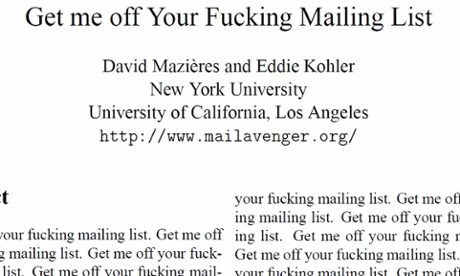
An open-access “predatory” academic journal has accepted a bogus research paper submitted by an Australian computer scientist titled Get Me Off Your Fucking Mailing List.
The paper, originally written by American researchers David Mazières and Eddie Kohle in 2005, consisted of the title’s seven words repeated over and over again. It also featured helpful diagrams.
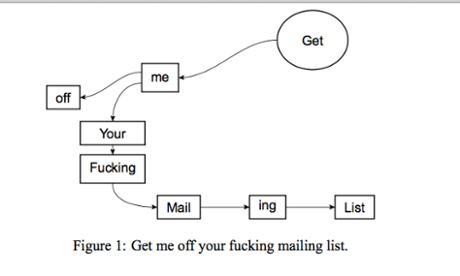
Dr Peter Vamplew, a lecturer and researcher in computer science at Federation University in Victoria, submitted the paper to the International Journal of Advanced Computer Technology earlier this year after receiving dozens of unsolicited emails from the publication and other journals of dubious repute.
“There’s been this move to open-access publishing which has often meant essentially a user-pays system,” Vamplew said. “So you pay to have the paper published and it’s available to the public for free.”
An academic librarian at the University of Colorado, Jeffrey Beall, told Nature magazine last year that up to 10% of open-access journals were exploiting the model by charging a fee to proofread, peer-review and edit a research paper without actually carrying out the work.
“They’re predatory journals, preying on young, inexperienced researchers who unwittingly don’t realise they’re of questionable quality,” Vamplew said.
Vamplew said he submitted the paper expecting the journal’s editors would “read it, ignore it, and at best take me off their mailing list”.
Weeks later he received good news: “It was accepted for publication. I pretty much fell off my chair.”
In line with the highest academic standards, Get Me Off Your Fucking Mailing List had been subjected to rigorous, anonymous peer review.
“They told me to add some more recent references and do a bit of reformatting,” he said.
“But otherwise they said its suitability for the journal was excellent.”
Vamplew was required to pay a $150 fee to have the paper published, but he declined.
The scheme has earned Vamplew some online recognition, but sadly his main aim remains unfulfilled.
“They still haven’t taken me off their mailing list,” he said.
The editors of the journal have been contacted for comment.
Monday, 24 November 2014
Mumbai - On the verge of an implosion
Bachi Karkaria in The Guardian
It used to be India’s urban showpiece. Today, its sceptre and crown have fallen down and, in a phase of cynical destruction masquerading as “development”, Mumbai has become a metaphor for urban blight.
Consider these statistics. Rubbish could be its Mount Vesuvius. Some 7,000 metric tonnes of refuse is spewed out each day. Dumping grounds are choked, yet there is no government-mandated separation or recycling.
Around 7.5 million commuters cram themselves into local trains every day and the fledgling metro and monorail are unlikely to make a perceptible difference in the near future.
There are 700,000 cars on the road and the authorities indirectly encourage private vehicle ownership by adding flyovers and expressways, instead of building or speeding up mass rapid transit systems. Private vehicle numbers have grown by 57% in the past eight years, compared with a 23% increase in public buses.
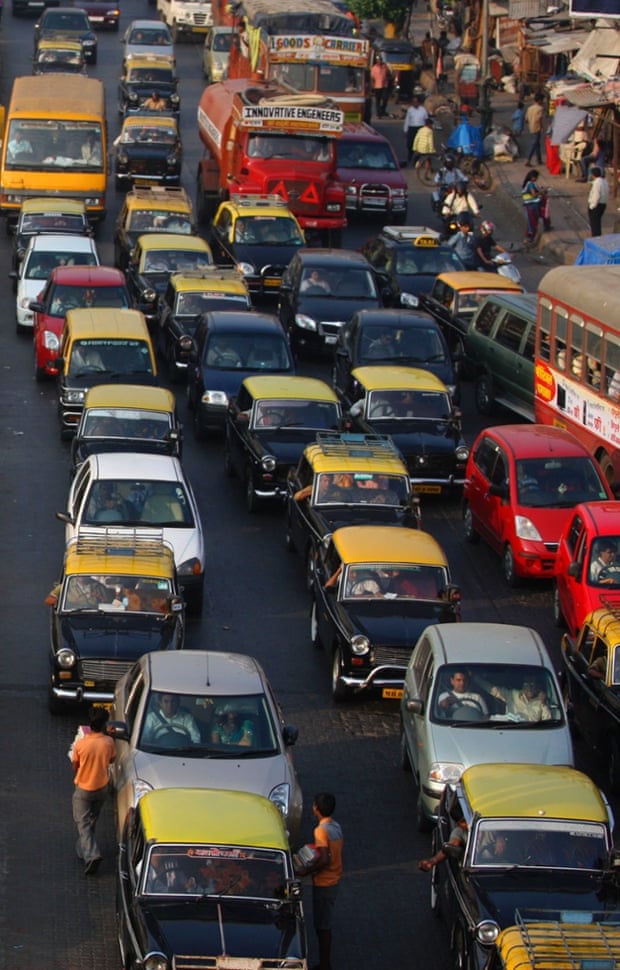
Toxic nitric oxide and nitrogen oxide levels stand at 252 microgrammes per cubic metre (mcg/m3) more than three times the safe limit of 80 mcg/m3. Protests against sound pollution fall on deaf ears.
There’s less than 0.03 acres of open space per 1,000 people. The global norm is four; London has a profligate 12.
There are 12.7 million people jammed into the 480 sq km that comprise today’s Greater Mumbai, that’s 20,680 people per sq km. We are the world’s eighth most-populated city – and dying to prove it.
As a consequence, every sixth Mumbaikar lives in a slum. The premium on land was exacerbated by the Rent Control Act of 1947, which wasn’t amended till 1999. Too little, too late. Real estate prices are unreal. It’s cheaper to buy a flat in Manhattan than in Malabar Hill, and you can be sure that shoddy materials will shortchange you in Mumbai.
Considering that housing is the city’s biggest shortfall, it’s ironic that unbridled construction is indisputably its biggest problem. Many villains have been blamed for Mumbai’s descent into urban hell, from mafia dons to impoverished migrants, but for the past three decades the main culprit is the “politician-builder nexus”.
In 2005, the entire city was held hostage for three days. On 26 July, suburban Mumbai was lashed by 668 mm of rain in just 12 hours. Unwarned commuters and children in school buses were left high, but not dry, as roads and railway tracks disappeared. Slums and BMWs went under the deluge without discernment for their economic standing. It may have been the country’s financial capital, but in the photographs that followed, swaggering Mumbai didn’t look much different from a monsoon-marooned Bihar village.
For this humbling disaster, the finger pointed at that same culprit: the developer and his facilitator, the politician. There was nowhere for the rainwater to go. For decades the concrete army had been allowed to commandeer all open spaces, and illegal encroachments had done the rest. Public parks, verdant hills, salt-pans, school compounds, private garden plots, beaches, mangroves – nothing was spared.
The built environment in Mumbai had increased fourfold since 1925 – and at its fastest rate over the past 30 years – all at the cost of green cover and wetlands.
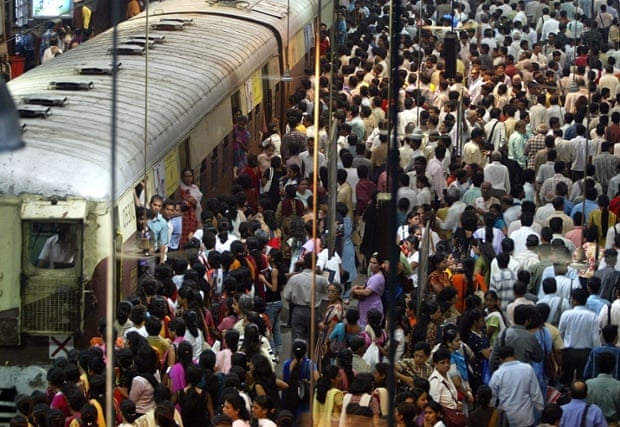
The 2005 deluge brought to light the little-known fact that Mumbai had a river. The Mithi had been reduced to little more than a turgid drain, bubbling with the putrefactions of one of Asia’s largest slums, Dharavi. Why blame its desperate inhabitants when the authorities had built an airport runway and much of the swanky new business district of the Bandra Kurla complex over it?
The traumatising flood was a flash-point. Citizens rose against all the civic atrocities heaped upon them. Why must they suffer such acute and chronic brutalising when Mumbai was the biggest contributor to the national economy? It accounts for 33% of income-tax, 20% of central excise collections, 6.16% of GDP (the largest single contribution in India), 25% of industrial output, 40% of foreign trade and 70% of capital transactions.
Activists demanded it should be administered separately under a chief executive-like head, instead of politicians who siphoned off its wealth to their rural constituencies. The municipal commissioner should be answerable to the elected corporate leaders not, illogically, to the state chief minister. But all this sound and fury receded with the flood waters, and it was soon business as usual.
The unequal war between profiteering and civic wisdom was in unabashed evidence some 20 years before this great flood. An eagerly anticipated shot in the arm turned into a wound that still festers. The cotton mills, on which Mumbai’s original fame and fortunes were built, had been killed off by the prolonged strike of 1982 (and chronic neglect by their owners).
After nearly a decade of legal wrangling, especially over the laid-off workers’ dues, it was decided to redevelop the defunct land – an eye-popping 600 acres in prime south and central Bombay. Recreational spaces, public housing and private enterprise were each to get a one-third share of the total area.
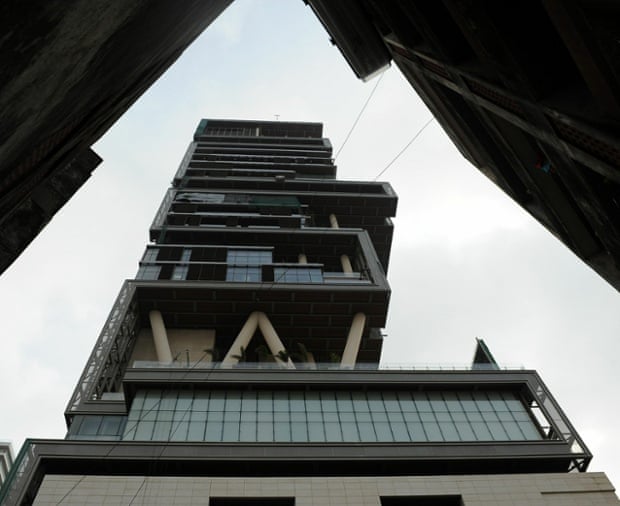
But in 1991, the relevant Development Control rule 58 was unilaterally changed by the chief minister, making only “open” land in the mills eligible for the division. This left the lion’s share to the owners, their builder accomplices and, naturally, the obliging politicians. The city got a mere fifth of its desperately needed windfall.
Instead of the imaginative, integrated development plan drawn up by Charles Correa, the renowned Mumbai-based architect, the former mill-hub of Lalbaug-Parel is a soulless cram of skyscrapers, mall-to-mall carpeting and snarled traffic clashing with the tenements housing the dispossessed worker families.
The opportunity for Mumbai’s redemption was obscenely squandered. The greedy, selfish “development” has worsened, instead of alleviating, its two biggest headaches: housing and traffic.
Now, a new phoenix is projected to rise from the 800 acres of decrepit dockland along the city’s eastern shoreline, again in the prime south. Will the city finally get its life-saving leisure space and affordable housing? Or will it be one more land-grab hastening its death by “development”?
Mumbai waits with more cynicism than hope.
Subscribe to:
Comments (Atom)
